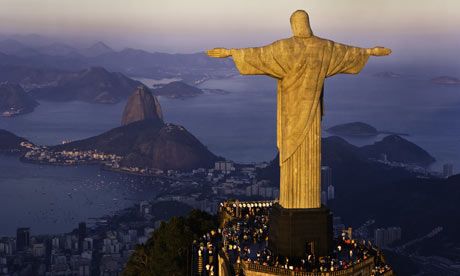According to the new religions map of Brazil, coordinated by
sociologist Marcelo Neri, Catholics have dropped from 73.8% of the total
Brazilian population to 68.4% in 2009, which represents a fall of 5.4
percentage points.
Simultaneously evangelists now represent 20.2% of the population
compared to 17.9% in 2003, and those with no religion (atheists and
agnostics) have jumped from 5.1% in 2003 to 6.7% in 2009.
The report was based on data collected from 200.000 interviews under
the Family Budget survey undertaken by Brazil’s geography and statistics
institute, IBGE.
The fall in the number of Catholics has been gradual but sustained
from the start of last century, but had remained reasonably stable in
the previous 2000/2003 survey by FGV.
“In 2009 we have arrived to the lowest level of Catholic adepts in
Brazil’s documented history”, says the report. “We observe the fall in
the percentage of Catholics is extensive to all age groups. The change
was lesser for the older age groups and greater among the young
generations”.
Such a reduction opened space for other beliefs as well as atheists and agnostics.
The evangelist “Assembly of God” has become the second strongest
church in Brazil (in numbers) with great influence in D and E income
sectors” said Marcelo Neri, who added that it is clearly advancing on
sectors A and B.
Evangelists have advanced in all age groups but penetration is much
greater among the young.
In the emerging class C, evangelists represent
21.5% of the population, above the national average (20.2%).
Catholicism is the religion with greater presence in the extremes of the
income spectrum (72.7% in class E and 69% in AB), while the evangelist
and Pentecostal have become more popular among the mid lower half of
income distribution (15.3% in Class D). Traditional evangelists are
concentrated at AB (8.35%) and C (8.7%).
Regarding geographical distribution the greatest concentration of
Catholics is in the north east of Brazil with the state of Piauí having
87.9% Catholics compared to the national average of 68.4%.
“Data shows that the long standing Brazilian poverty, in rural areas
of the north-east, which are also the most supported with social
programs, remain Catholic while the new poverty (like the non aided
urban periphery of the large cities) seems to be migrating to the new
Pentecostal churches and non religion, according to FGV.
At the same time family per capita income of evangelists is 6.9%
lower to that of Catholics, precisely because Catholicism still has a
relevant presence among the Brazilian economic elite.
As to gender, Brazilian women at the same time they are more
religious than men, they are also currently less Catholic: among those
declaring a religion, 75.3% of men say they are catholic which compares
with the 71.3% for women.
“While men simply abandon beliefs, the women change church, preserving more than men their religiosity”, says the FGV reports.






No comments:
Post a Comment